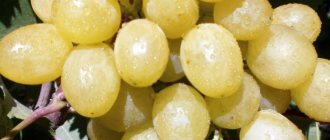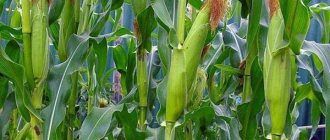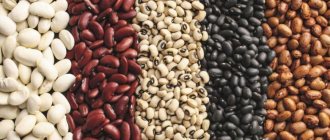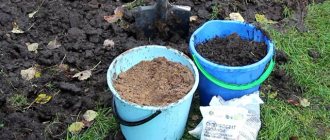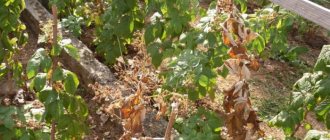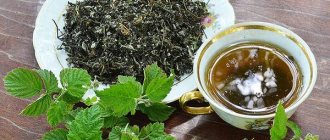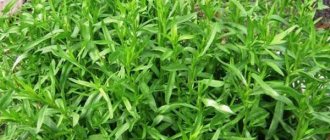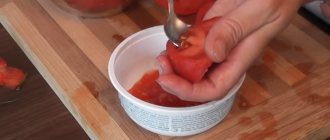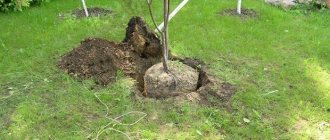- Sapropel
Raspberry is a shrub with perennial characteristics. The stems grow for 2 years, like perennial herbs, but the root system develops over several years, like shrubs. The root system grows 2 m wide and is of the surface type. The germination depth is no more than 0.4 m. Individual root shoots can penetrate 1-1.5 m in depth. This only happens in extremely difficult growing conditions, when raspberries are forced to independently search for an additional source of nutrients.
Features of raspberries when choosing soil
The characteristics of the root system determine the requirements for the soil. First you need to decide what kind of soil raspberries like: acidic or alkaline. The optimal soil acidity level for raspberries is in the range of 5.7-6.5 Ph. As this indicator decreases, the yield of the bushes decreases, and the taste of the berries deteriorates, they become smaller and become sour. Special attention should be paid to the water regime, since the soil for raspberries should always be moist, and stagnation of water should not be allowed. The structure of the soil should be loose, saturated with fertilizers.
Soil for raspberries
Having decided what kind of soil is needed for raspberries, you can begin to diagnose the garden plot where you plan to plant. After determining the soil characteristics in the garden, you can draw a conclusion about why raspberries do not grow on the site, and take measures to improve the composition of the soil or change the location of planting the raspberry bushes.
What kind of soil does raspberry like?
First of all, the soil in the garden should be well-drained, loose, and airy. A rich organic composition is welcome, this promotes the development of beneficial microorganisms that improve the soil.
The best soils for raspberries:
- Loam is a loose and moderately nutritious soil. It is easy to identify by its appearance: it is coarse-grained and easily breaks into pieces when wet. If the wet soil is plastic and solid, then this indicates an excess amount of clay. This is no longer very good for raspberries.
- Sandy loam soil is also loose and clumps worse than loam.
What is definitely not suitable for growing raspberries and other garden crops is heavy clay soils. In them, the root system is deprived of oxygen, and it is extremely difficult for air to penetrate into the deep layers. Clay also prevents the rapid evaporation of moisture. In such conditions, the roots become rotten and quickly become infected with fungus or viruses.
Sandstones are also not recommended: nutrients do not retain in the upper layers of such soils.
Methods for determining soil acidity
Device - tester
What kind of soil does black currant like?
In the modern world, many gadgets have been developed that solve different problems. For summer residents, a Ph-meter was invented - this is a technical tool for determining the acidity of the soil. The device is quite simple: a handle with a screen on which the values are displayed, and a probe that is immersed in the ground. The filling of the device is not so simple and consists of a probe - an electrode. Before use, be sure to wipe the dipstick with a dry cloth.
Soil acidity determination device
It is important to know! The test area and the device itself should not be touched with bare hands, as this will affect the test result.
The probe must be lowered into the ground, after which the following value will appear on the screen:
- Less than 7 Ph – acidic,
- 7 Ph – neutral,
- More than 7 Ph is alkaline.
Litmus paper
The test, known since school days, nevertheless, does not lose its relevance. To do this, you need to take earth and distilled water and stir them until they have a porridge-like texture. This mixture should be left for a quarter of an hour, then repeat the procedure and leave for another 5 minutes. After time, the heavy components will settle to the bottom, and a liquid will remain on the surface into which the litmus must be immersed. Usually there is a diagram on the packaging that shows the acidity level and the corresponding color of the paper after the test:
- Red color – acid level is very high;
- Orange color – medium acidic soil;
- Yellow color – slightly acidic composition;
- Light green color – neutral value;
- Bright green color – alkaline soil.
Litmus paper
Natural indicator
to determine the acid content in the soil intended for planting raspberries using the plants that predominate on the site:
- Field bindweed, alfalfa and wheatgrass grow in large quantities on alkaline soils;
- Acidic soil is the optimal habitat for plantain, cornflower, horsetail, and buttercup;
- A neutral environment is favorable for clover, coltsfoot, and burdock.
Currant leaves will help determine the acidity of the soil for raspberries:
- Pour boiling water over fresh leaves for 15 minutes;
- Remove the leaves and cool the infusion;
- Take a lump of earth and place it in a decoction. Acidic soil reacts and the infusion turns red. From neutral soil the infusion becomes green, and from alkaline soil it turns blue.
The required acidity level and methods for determining it
Slightly acidic soil suits raspberries. The acidity level should vary between 5.5-6.5 pH.
Methods for determining soil acidity:
- Using a device called a pH meter. It is a handle with a screen where indicators are displayed, combined with a probe for immersion into the ground. The probe is wiped with a dry cloth and lowered into the ground. Do not touch the ground in the testing area and the probe with your hands; the result will be distorted.
- Using a litmus strip. You need to pour a handful of earth into the jar and fill it with water (1:4). Stir and wait until sediment appears. Dip the litmus indicator into the water for a few seconds. Red color indicates a high level of acidity, orange indicates moderately acidic soil, yellow indicates slightly acidic soil, and light green indicates neutral soil. A deep green color means the soil is alkaline.
Read also: Onion juice with honey for cleaning blood vessels
The desired acidity level can be obtained by adding additives:
- To reduce acidity, dolomite flour is added, which simultaneously saturates the soil with magnesium and calcium. A more affordable method is to add ordinary wood ash at the rate of 100 g per 1 m2.
- Alkaline soil is quickly acidified by organic matter, leaf compost and rotted pine needles.
Observant gardeners can determine the composition of the soil in the area by looking at the weeds. Alfalfa and wheatgrass thrive in alkaline soils. Horsetail, plantain and cornflower prefer sour ones. If you have to frequently weed out clover and burdock on your site, it means that we are talking about a neutral environment.
Soil moisture, control methods
What kind of soil does garlic like?
The soil for growing raspberries should be moderately moist. Excessive moisture is acceptable at the time of formation and ripening of berries. For plantations of raspberry or blackberry bushes, it is beneficial to use drip irrigation. Instrumental methods are used to competently plan the irrigation system.
A soil tensiometer is a tool for determining the moisture level in the soil. Consists of a pressure gauge and a tube with a ceramic probe. You need to take measurements after watering, installing the device in the thick of the plants and immersing the tube to the depth of root germination. Meter readings are taken in the morning. For ease of measurement, the pressure gauge is divided into multi-colored zones:
- Red zone – overdried soil, urgent watering;
- Yellow zone – lack of moisture, additional hydration is required;
- Green zone – optimal humidity;
- The blue zone is excess moisture.
Soil tensiometer
The predominant plants in the area also indicate soil moisture. Willow, alder, reed, and willow grow on soil with excess moisture. Thyme, saxifrage, and sedum grow best in dry and poor soils.
Preparing the soil for planting includes changing the composition of the soil. Heavy clumping soil is mulched with peat and/or sand. The composition of excessively loose low-fertility soils is enriched by adding organic matter.
Nuances of preparing sandy and clayey soils
As noted earlier, raspberry bushes love loamy and sandy soil. However, in many regions the soil is characterized as sandy or clay. The situation can be corrected by careful preparation of the site.
Heavy clay soils need to be loosened. To do this, the following is added to the land:
- leaf compost;
- coarse river sand;
- straw (pre-chopped);
- peat is not acidic.
The amount of such components depends on the density and fat content of the earth. To test whether baking powder is still needed, a small area of soil can be watered thoroughly and left to dry. If after this a cracking crust forms on the surface of the earth, the dose is increased.
Next year, the condition of the soil needs to be checked, as the sand is washed away by water and settles.
Sandy (poor) soils are characterized by a lack of organic compounds and potassium, and therefore require annual maintenance. The following must be added to the site:
- sapropel (freshwater silt);
- a small amount of clay - it increases the viscosity of the soil;
- organic compounds.
Experienced gardeners recommend choosing horse manure among organic compounds. For poor lands, organic matter is applied twice a year. The site must be fertilized in the fall. In this case, in the spring the plants will be able to use nutrients for active growth.
We recommend that you familiarize yourself with Honeysuckle Silginka
Increasing fertility by mulching
Sapropel
What kind of soil does cabbage like?
Sapropel is a natural organic fertilizer consisting of plants, living organisms and soil located at the bottom of a fresh reservoir. The formation of sapropel occurs over several decades, then it is removed to the surface and dried, resulting in a powder. Mulching the soil with sapropel makes the soil looser and more fertile. The optimal layer is considered to be 3 cm. The maximum effect of using this fertilizer is achieved on clay soils.
Sapropel
Purchased soil
In some cases, the most budget-friendly and effective option is to change the soil composition by adding purchased soil. When you need completely prepared soil, you can choose the “Garden Trommel” brand. To enrich poor soils or improve the characteristics of garden soil, you can use 100% black soil or black soil “AGRO line”.
Earthworms
The benefits of worms have been known for a long time. They make the soil loose and increase fertility. To breed worms, you need to take a container and fill it with manure and plant remains. Adults, fry and cocoons should be added to this mixture in a ratio of 8:1:1. During their life, the worms will process the mixture into nutritious vermicompost.
Soil fertility
Peat not only loosens the soil, but also increases its fertility. It is used for mulching bushes, covering the surface of the plot with a layer 5-10 cm thick.
It inhibits the growth of weeds and prevents the soil from cracking around the stems. It is applied as a top dressing. Slow-acting fertilizers such as grass, hay, and bark also increase fertility.
Other effective measures are used to improve fertility:
- adding sapropel, which is a silt deposit and consists of organic matter and minerals;
- breeding earthworms, each of them produces about 100 kg of humus per year.
Often the process of preparing and improving the properties of the soil for raspberries is labor-intensive, but this is the only way to get healthy, powerful bushes that will yield a bountiful harvest.
Raspberry is a shrub with perennial characteristics. The stems grow for 2 years, like perennial herbs, but the root system develops over several years, like shrubs. The root system grows 2 m wide and is of the surface type. The germination depth is no more than 0.4 m. Individual root shoots can penetrate 1-1.5 m in depth. This only happens in extremely difficult growing conditions, when raspberries are forced to independently search for an additional source of nutrients.
Read also: Steamed quince in a slow cooker
Traditional methods: organic fertilizers
- Manure is used both fresh and rotted. Fresh can burn plants, so it is applied in the fall (in the second ten days of October) - 5 kg/m2. Rotted manure is safe and can be applied in the spring before planting. Consumption rate – 3 kg/m2. Compost is made from manure by mixing it with peat 1:3. This preparation is made in the fall, and applied during the spring planting period, in the first half of April, when the soil dries out;
- Ash is a valuable potassium-phosphorus fertilizer, enriches the soil, and this contributes to a high yield; the berries have a rich taste and aroma. In addition, ash has a neutralizing effect. Application rate – 0.3 kg/m2. Application period: after flowering;
- Shells are an effective soil loosener, especially clay soil. It can also reduce soil acidity. Consumption – 0.2 kg/m2;
- Bird droppings, like manure, come in two forms. It is also recommended to apply fresh litter in mid-October (0.5 kg/m2), and rotted litter in mid-April (0.3 kg/m2).
What soil is suitable for fruit trees and berry bushes
The beginning of autumn is the time of planting fruit and berry crops. Fruit trees can be planted in autumn and spring. However, in the spring in the Non-Black Earth Zone, their seedlings still take root and grow better.
But berry crops should be planted in the fall, since in the spring they awaken early, their buds begin to open, and in this form the seedlings take root worse, get sick, and often even die.
When choosing plants and a place to plant them, we always ask ourselves the question: will the crop be good on the site, will it give a good harvest, will it grow for a long time, delight with lush flowering and tasty fruits or berries.
Gardener's Guide
Plant nurseries Garden supply stores Landscape design studios
By selecting a planting site at random, without taking into account the condition of the soil, we risk providing the planted tree or shrub with conditions that are not entirely or not at all suitable for its normal development. At the same time, demanding too much on unprepared or unsuitable soil and not getting what we want, we begin to blame the seedling sellers, which is most often unfounded. In this article I will try to talk about the most common fruit and berry crops and their preferences for soil conditions.
Apple tree
Let's start, of course, with the queen of gardens - the apple tree. This crop is light-loving; even slight shading can lead to excessive shedding of the ovary and, of course, to a decrease in yield.
The apple tree prefers different soils; it can grow quite well on gray forest, sod-podzolic, and chernozem soils, but all of them must be of light mechanical composition and have a neutral or, in extreme cases, slightly acidic reaction.
The apple tree cannot tolerate excess water, so it should not be planted in microdepressions. She is also wary of groundwater levels located closer than 1.5 meters to the soil surface. It is better to plant an apple tree on rested soils, perhaps after vegetable crops, but not after an apple or pear tree.
Pear
The pear tree is almost as popular among the people as the apple tree. This is a more problematic crop, which, unfortunately, often freezes in gardens.
To prevent this, choose areas with a southern orientation for planting pears, and avoid places with prevailing northern winds.
As for the soil, the pear simply loves moist soils; of course, they should not be swampy, and the groundwater level should not be closer than a meter.
The best soil composition is loam and sandy loam, slightly podzolized soils, leveled without microdepressions and depressions.
Cherry
Juicy and sweet cherries, which are now receiving a lot of attention, just like pears, love a lot of light and are not particularly winter-hardy - it is better not to plant them in depressions. Cherries love well-ventilated places - there they are less likely to get sick, and they love fertile soils with a light mechanical composition, high breathability and a neutral reaction. Light and medium loams are what she needs, and with annual fertilization, the harvests will be large and constant.
Plum
Sweet and juicy plum is a kind of northern peach. She, like her beautiful brother, loves warmth and sunlight. In the shade, even for a short time, you should not expect a good harvest, but if you plant a seedling on the south side in moist, loamy soil that has a thick fertile layer and a neutral reaction of the environment, then the plum will definitely give you a rich harvest of delicious fruits. He is afraid of draining high groundwater; it will be better if it is no closer than 1.5 meters from the soil surface.
Sea buckthorn
Sunny berry - sea buckthorn in any region prefers the sunniest place, in the shade and grows poorly, and produces low yields.
The best soils for sea buckthorn are fertile with plenty of moisture, light, with a groundwater level no closer than a meter to the soil surface.
When planting sea buckthorn in place after uprooting the garden, avoid places with stone fruit crops that previously grew on them.
To avoid the accumulation of common pests in the soil, do not plant it next to strawberries or raspberries. Sea buckthorn in any region of cultivation necessarily needs a pollinator; usually, for every 5-6 female plants, at least two male forms must be planted.
Hazelnut
Recently, hazelnuts, a tree of longevity, have also become popular.
It can be given either a well-lit or slightly shaded place on the site, but the soil must be well cultivated, loose and very fertile.
There is a pattern in the ratio of walls and pulp - on coarse, low-nutrient soils with a lack of moisture, the pulp in the nuts is significantly less. The best soils are loams.
When growing hazelnuts in the Black Earth region, try to select sufficiently aerated soils with a groundwater level no closer than a meter.
Chokeberry
Chokeberry is considered an excellent remedy for high blood pressure, everything is simple - this crop is completely undemanding to soil, has high winter hardiness, which allows it to be grown in regions with different climatic conditions on most types of soil. The only thing I would like to note is that you need to remember: chokeberry responds in its own way to overly nutritious soils or to the application of large doses of fertilizers. There will be a sharp increase in crown growth against the backdrop of a fairly strong, even complete, reduction in yield.
Currant
Another king of the garden, only from a different tier - among the bushes - these are red and black currants. Unfortunately, over the years of their cultivation, these crops have accumulated many pests and diseases, so, unfortunately, not a single season can do without treatments. To somehow reduce the number of sprays harmful to humans, try to plant currants on clean soils. It is better if the predecessor is pure steam.
Soils for currants are preferably chernozem, well-warmed, aerated, without stagnant melt or rainwater, because this causes powdery mildew. In regions with a predominance of gray forest soils, pay attention to the acidity - it must be at pH-5.5. Try not to plant currants near gooseberries or raspberries.
Gooseberry
This crop is quite undemanding, drought-resistant, prefers breathable soils with a groundwater level of at least a meter, feels quite good in any region and produces rich harvests on any type of soil. There is reliable information that maximum yields were achieved even on highly acidified soils; gooseberries, perhaps, cannot tolerate only excess moisture. Therefore, in regions with excessive moisture, it is necessary to arrange drainage during planting.
Raspberries
It, like gooseberries, is not a very demanding crop when it comes to soil. At the same time, it is quite aggressive, its root shoots quickly spread throughout the area, causing gardeners a lot of inconvenience. “Unnecessary” places on the site are often allocated for raspberries, but this is biologically incorrect. Of course, raspberries will bear fruit there too, because even in low light conditions you can get quite bearable yields, but better fruiting and fairly good crop development can be achieved only in areas whose soils are rich in nutrients, are permeable, light and have a slightly acidic reaction environment.
Kalina
A pleasant plant - it blooms beautifully and produces healthy fruits.
This crop is just for those regions where there are an abundance of rainy days during the season. Viburnum loves moisture, produces abundant growth and a good harvest.
Of course, you shouldn’t plant it directly in a swamp, but it will grow well near a pond. A good option is if the soils allocated for viburnum are well cultivated and fertile.
Viburnum can grow well in the shade, but it is better to allocate well-lit areas for it.
Rowan
Recently, thanks to the work of breeders, the demand for rowan fruits has revived. This is a crop that is relatively undemanding to soil conditions and is ideal for regions where the soil composition is not very fertile.
Rowan loves light, but can withstand slight shading with dignity. Varietal rowan is slightly less winter-hardy than its wild-growing sister, but even varieties can withstand frosts down to -40oC. The ideal soils for mountain ash are limed, poor, and even drained marshy soils.
Irga
This is a magnificent crop, a children's sweet berry. Its mass distribution is stopped, perhaps, only by its high growth and the difficulty of collecting ripe fruits that arises with age.
Irga can grow and produce good yields on any type of soil.
It can grow even in rocky areas; depressions and depressions are not dangerous for serviceberry, the soil is acidified and too dry. It can be planted on the periphery of plots in those regions where winters are too cold.
By retaining snow on the site and restraining gusts of northern winds, serviceberry can also serve as protection for more heat-loving plants.
Bird cherry
Bird cherry is close to the demanding serviceberry and useful. This crop, which is now given only a decorative place, will grow on any type of soil without fertilizers and watering in almost all regions of Russia. You should only be wary of very swampy soils, although bird cherry loves moisture.
Dogwood
The dogwood, beloved by many, prefers well-cultivated soils, rich in organic matter and minerals. In regions where the soil is poor, sandy or clayey, fertilizer application should be taken care of in advance. The planting pattern for dogwood is also different: it depends, first of all, on the fertility of the soil. So, on soils characterized by high nutritional value, it is necessary to plant plants less frequently, but on poor soils - more often.
Barberry
The thorny plant, which is often used to create an impenetrable hedge, prefers soils of varied mechanical composition.
Barberry grows and produces good yields on loose loams, sandy soils and leached chernozems.
Preferring open areas without shade, it is highly wind-resistant and resistant to low negative temperatures.
In regions with highly compacted soils, small amounts of peat may be added during planting.
Blueberry
Tender blueberries simply love sunny places and prefer acidic soils with plenty of moisture. In regions with harsh climates and sandy soils, it is necessary to cover plants for the winter. The best soils for blueberries are peat-sandy and peat-loamy, well-drained with a high humus content. Blueberries love prosperity and even an abundance of moisture, which another widespread crop, strawberries, cannot tolerate.
Strawberries
Even one flooding with rain or melt water can be enough for all plants to die. The best soils for strawberries are considered to be structural, highly moisture-absorbing, with a high content of humus and nutrients and an environmental reaction close to neutral.
Honeysuckle
Early honeysuckle also does not like excess moisture. However, this crop is quite unpretentious and grows well on soils of any mechanical composition, therefore it is grown in all regions of Russia. Possessing high winter hardiness, honeysuckle can easily endure harsh winters on soils of heavy mechanical composition in the northern regions.
Actinidia and lemongrass
In conclusion, I would like to talk about two wonderful liana-like crops, the fruits of which are characterized by a high content of vitamin C - the vitamin of health and longevity. These are actinidia and lemongrass. Both crops are vines and therefore must be grown on a trellis.
They love fairly good lighting, well-drained soils, characterized by a slightly acidic reaction, which are not characterized by flooding.
It is better to avoid microdepressions and depressions, especially in regions with a harsh climate, because in such areas lower temperatures are usually observed, which can be detrimental for rather weakly winter-hardy crops.
Nikolay Khromov,
Candidate of Agricultural Sciences, Researcher, Department of Berry Crops, State Scientific Institution VNIIS named after. I.V. Michurina, member of the NIRR Academy
Improving soil in different regions
In the Central and Northwestern regions, there are mainly heavy soils that require the addition of loosening compounds. Sand and peat work well. There is no need to acidify the soil, as the acidity level ranges from normal to strongly acidic. It is beneficial to add eggshells.
In the southern regions, on the contrary, the priority is to acidify the soil. The soil quality is high, black soil predominates. Sapropel and potassium are suitable as fertilizers.
The soils of the Siberian region and the Urals are considered ideal for growing raspberries.
The main recommendation for improving soil quality is the application of organic fertilizers (manure, compost, ash). The structure, acidity and moisture of the soil correspond to the standards for growing raspberries, so care will not cause much trouble. Forest sod-podzolic soils are well suited for all varieties of raspberries, including the exotic Cumberland variety.
The benefits of mulching
Raspberries in open ground need mulching. The benefits of it are as follows:
- The evaporation of root moisture and the leaching of nutrients from the soil are slowed down.
- The roots are protected from temperature fluctuations and their consequences.
- The composition of the soil improves, as mulch acts as a loosening agent.
- The protective functions of the soil against pests are enhanced.
- The development of weeds is inhibited.
- Organic mulch regulates soil acidity and nourishes shrubs.
Sawdust, straw, grass, wood chips, agrofibre and other materials are used as covering materials.
Mulching raspberries
Errors in soil preparation
- Incorrect site selected. Raspberries develop well when located in the sun or partial shade. The shadow negatively affects the amount of harvested crop. In addition, the lack of sufficient light leads to the berries becoming smaller;
- Planting on clay soils. Why do raspberries grow poorly in such soils? Clay is not only heavy, dense soil. It causes water stagnation. Raspberry does not like such conditions. Therefore, you should not choose a clay area. If there are no other options, then you need to do thorough work to change the structure of the soil: add drainage, mulch with light soils, loosen the soil well, dig up the area in the fall;
- Uncontrolled plantings. Raspberries grow very quickly. Small shoots take a lot of energy and nutrients, but do not produce a decent harvest. In addition, an overgrown area is difficult to process. Therefore, you need to monitor the growth of raspberries and constantly remove excess shoots;
- Unregulated soil acidity. Every gardener who wants to get a good raspberry harvest should carry out the procedure for determining acidity. In addition, acidified soils are a favorable environment for the development of fungal diseases;
- Planting raspberries in an old uprooted plot is a gross mistake by gardeners. In the old place, after removing the bushes and roots, all diseases and pests remain, the soils are depleted, which is why new raspberries do not take root on the site. You can plant a raspberry tree in the place of the old one no earlier than after 6 years.
Raspberries, like remontant strawberries and grapes, have special requirements for soil quality. To get a good harvest, you need to prepare thoroughly: study the composition of the soil, analyze its structure, and, based on the collected data, take measures to improve the quality of the soil. Compliance with soil acidity and moisture standards, as well as timely fertilizing will give excellent results.
Preparing the soil for autumn planting raspberries
After planting, raspberry bushes can grow in one place for several years. The plant does not need to be replanted often. In order to ensure a rich harvest of berries for several years, you should take care in advance of the correct selection and preparation of a site for raspberries.
We recommend that you familiarize yourself with Barberry Red Rocket
In this case, several nuances should be taken into account.
- Abundance of sunshine. In shaded areas, the shrub grows more slowly and the berries take longer to ripen.
- It is important to ensure that the plantation is not located on swampy soil. Stagnation of moisture causes rotting of the root system and death of the bush.
- Wind protection. For active growth and high yields, bushes need to be protected from strong gusts of wind.
When planting a new raspberry tree, you should take into account what plants were grown in this area previously and what type of plant will be adjacent to the bushes next year.
It is not recommended to plant a plantation in the place where the following grew before:
- eggplant;
- potato;
- strawberries;
- pepper;
- old raspberry bushes.
Berry bushes prefer soil that was previously occupied by:
- calendula;
- legumes;
- garlic;
- onion;
- parsley;
- lupine (such a plant is destructive for the beetleworm - the main insect pest for raspberries).
Preparing the soil for planting raspberries begins in mid-summer. It is recommended to plant green manure in the selected area. Among them are peas, oats, vetch and wheat. After the planted plants have completed their growing season, they are plowed into the ground and berry bushes are immediately planted.
Thanks to plant parts in the soil, it is possible to increase the amount of useful microelements in the soil and enrich the upper layers with air. This approach is extremely important if the plantation is located on dense loam.
Choosing a landing method
There are two ways to plant raspberries: bush and tape or trench. The choice depends on the variety and location on the site. In any case, be sure to maintain the distance between bushes and rows. If you plant them very close, the plants will interfere with each other, which will affect the yield.
Belt method
This is a convenient way to grow a large number of bushes. They are planted in a row, in a dug trench 30-50 cm deep. It is better to place it in the direction from north to south. The distance between adjacent rows should be 1.5-2 m. It is recommended to immediately install a trellis for gartering the shoots.
They need to be planted at a distance of 0.5-0.7 m from each other. Sometimes it is recommended to place bushes closer - up to 30 cm from each other. But remove all shoots between rows to prevent thickening. The width of each row should be 1 m.
Bush method
With the bush method of planting raspberries, holes are dug where it is convenient. They can be arranged randomly or in a row. If the bushes are nearby, the distance between them should be at least a meter. Dig holes a month in advance and fill them with prepared soil mixture and fertilizers. The diameter of each hole must correspond to the size of the seedling's root system so that the roots do not bend.
